Memories
On this page I'll look back to my first experiences with computers and became
enthousiastic about them step by step.
At that time I tried to study Electrotechnics in Amsterdam but switched to
Computer Science in Enschede later on.
Looking back does not say I want to go back to these periods in the history
of computers. Todays computers have much more software available to ease
your work or to make some fun.
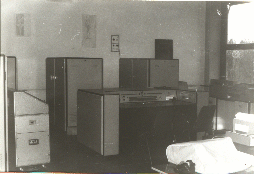
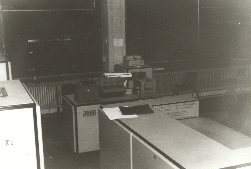 I remember the first computer I ever wrote a program for.
It was a very old Electrologica X1, built at the end of the 50s. It served
at the Mathematical Centre in Amsterdam and was taken over by the Technical
School. It was used as a first exercise to punch your Algol 60 programs and
compile and execute them on the X1. Except for power and space the X1 took
not much.
I remember the first computer I ever wrote a program for.
It was a very old Electrologica X1, built at the end of the 50s. It served
at the Mathematical Centre in Amsterdam and was taken over by the Technical
School. It was used as a first exercise to punch your Algol 60 programs and
compile and execute them on the X1. Except for power and space the X1 took
not much.
Just like her successor, the X8, the X1 had 27 bits words. The machine at
the HTS"A" had 16K words of memory installed in 4 separate cabinets.
The electronic modules of the X1 had the size of a package of cigarets
and contained of transistors, resistors and capacitors.
Both the Algol compilers aswell as the user programs entered the X1 via the
EL1000 high speed reader for punched tape.
Output appeared on the IBM typewriter. An important part of the I/O was the
BSP cabinet: right on the background on the right picture.
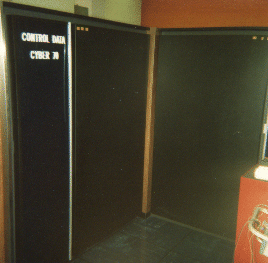
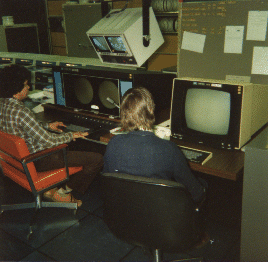 I remember the basement at the Boelelaan in Amsterdam, at that time the
centre of the academic computerpower for Amsterdam. SARA, the Amsterdam
Academic Computercentre took care of the main computers for the
University of Amsterdam, the Free University and the Mathematical Centre.
I visited the basement as early as 1972, introduced by my brother, who
worked for SARA.
Technicians were busy installing the CDC 6500, later renamed CYBER 73.
Bunches of cables, rows of cabinets and an impressive console with two tubes.
In these days the operating system must have been SCOPE. Later it became
NOS/BE with Intercom for interactive services.
I remember the basement at the Boelelaan in Amsterdam, at that time the
centre of the academic computerpower for Amsterdam. SARA, the Amsterdam
Academic Computercentre took care of the main computers for the
University of Amsterdam, the Free University and the Mathematical Centre.
I visited the basement as early as 1972, introduced by my brother, who
worked for SARA.
Technicians were busy installing the CDC 6500, later renamed CYBER 73.
Bunches of cables, rows of cabinets and an impressive console with two tubes.
In these days the operating system must have been SCOPE. Later it became
NOS/BE with Intercom for interactive services.
Being students of the nearby Technical School, we went to the Boelelaan very
frequently because of the facilities in the basement. We could run our batchjobs
more often in less time and we could track them on a monitor.
Later on we were allowed to work interactively using synchronous CDC 711
terminals.
Many of you may remember the hard "beep" noises these terminals produce when the system was contacted and data was transmitted.
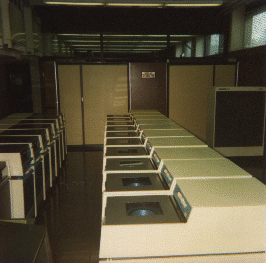
 The CYBER 73-28 with 2 cpus, 8 units of memory, 128KW memory (60 bit per word)
and 512KW background memory (ECS) got companied by a CYBER 173 (on the
background left picture) in 1976.
A faster machine in a smaller cabinet and probably less power consuming.
This new machine was used for interactive services during the office hours.
In order to promote SARA at the Technical School and show whats down there
in the basement we were allowed to go in and take pictures.
The CYBER 73-28 with 2 cpus, 8 units of memory, 128KW memory (60 bit per word)
and 512KW background memory (ECS) got companied by a CYBER 173 (on the
background left picture) in 1976.
A faster machine in a smaller cabinet and probably less power consuming.
This new machine was used for interactive services during the office hours.
In order to promote SARA at the Technical School and show whats down there
in the basement we were allowed to go in and take pictures.
Files that you liked to keep after your interactive session or batchjob were
removed when not used (attached) in 3 days.
On the left picture we see two rows of diskdrives. The left row shows the 116M
drives (6 bits per character) and the other row has double capacity.
That gives a capacity in the order of 3 GB.
So, anyway, to store information for a longer period of time, you should put
the data on tape (right picture).
At that time there still existed 7 track tapes along the well known 9 track
1600 BPI tapes that can hold at most 40MB of data.
SARA stored the tapes of the users in separate room. At one time they
had 7000 tapes stored (Source: SARA exhibition bulletin 1979/12)
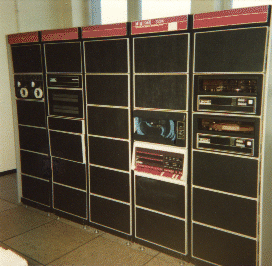
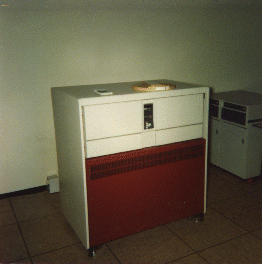 Once in the basement, a computer science student told stories
about "Unix on a PDP-11".
That's what we wanted to take a closer look at.
We were quite impressed by the huge PDP 11/45 (left picture) and
fortunately, the
system manager donated a free login account during
Christmas holidays.
I did not understand Unix from the first moments, but got used to
"ed" and compiled my Pascal programs interactively.
This happened at the end of 1977 and the PDP 11/45 ran Unix version 6.5.
Simple?? Well, "ls" produced a vertical row of filenames. The "pipe"
existed though the shell still used gotos and labels.
Once in the basement, a computer science student told stories
about "Unix on a PDP-11".
That's what we wanted to take a closer look at.
We were quite impressed by the huge PDP 11/45 (left picture) and
fortunately, the
system manager donated a free login account during
Christmas holidays.
I did not understand Unix from the first moments, but got used to
"ed" and compiled my Pascal programs interactively.
This happened at the end of 1977 and the PDP 11/45 ran Unix version 6.5.
Simple?? Well, "ls" produced a vertical row of filenames. The "pipe"
existed though the shell still used gotos and labels.
Five cabinets and two external AMPEX diskdrives of 80MB each.
You were allowed to keep your files for a longer time, but in the event
of a disk being full, the "Black List" was printed and the biggest users
had to cleanup.
One of the cabinets contained two BA-11Fs full of core memory (128KB each in
stacks of 32KB).
Once, during a weekend, one of the core stacks failed and the machine crashed.
One of the professors instructed me over the telephone to
reboot single user (putting 011450 at the switch register) and run "icheck"
and "dcheck" as instructed. (no "fsck" yet)
Unix never let me go since then.
The right picture shows the PDP 11/60, that joined the 11/45 later, and the
two AMPEX diskdrives in the
background.
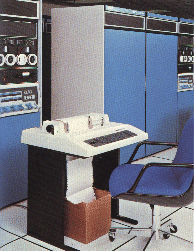
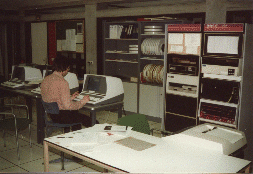 The DECsystem 10 at the Technical University of Twente was quite a different
type of mainframe computer compared to the CDC CYBERs.
The DEC employed forced air cooling in stead of liquid cooling as the CYBERs
use.
Forced air cooling makes hell of a noise for a big machine like the DEC-10.
The computerroom once was very quiet when the machine had to be switched off
for moving parts of it.
The DECsystem 10 had a 36 bit cpu and 512KW memory. A couple of built-in
PDP 11/40s are used for the communications with the terminals, the
disk controllers, the synchronous datacom and the slow peripherals.
If you opened one of the blue cabinets, you were face to face with a 11/40
frontpanel.
Digital used the same modules in 16, 18 and 36 bit machines: e.g. the core
modules were used with parity in 16 bit machines and without in 18 and 36
bit machines.
The DECsystem 10 at the Technical University of Twente was quite a different
type of mainframe computer compared to the CDC CYBERs.
The DEC employed forced air cooling in stead of liquid cooling as the CYBERs
use.
Forced air cooling makes hell of a noise for a big machine like the DEC-10.
The computerroom once was very quiet when the machine had to be switched off
for moving parts of it.
The DECsystem 10 had a 36 bit cpu and 512KW memory. A couple of built-in
PDP 11/40s are used for the communications with the terminals, the
disk controllers, the synchronous datacom and the slow peripherals.
If you opened one of the blue cabinets, you were face to face with a 11/40
frontpanel.
Digital used the same modules in 16, 18 and 36 bit machines: e.g. the core
modules were used with parity in 16 bit machines and without in 18 and 36
bit machines.
The operating system, TOPS-10, highly promoted the interactive use of the
DEC-10. In a separate room a number of 300 Baud DECwriters were lined up for
public use. Just a few VT52s (2400 Baud?) were available.
I was a volunteer at the computer department of the THT and worked
a lot on the PDP 11/45 running RT-11 and OMSI Pascal (right picture).
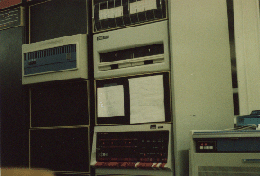
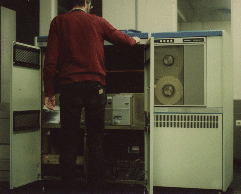 Unix played a very important role at the Faculty of Science of the Nijmegen
University.
In those days tens of ADM-3A terminals were connected to a few PDP-11s.
These machines running Unix v7 on 248KB memory and a 67MB CDC 9730 disk were
quite busy running "ed", "nroff/troff" and some programming work in C
or Fortran.
Unix played a very important role at the Faculty of Science of the Nijmegen
University.
In those days tens of ADM-3A terminals were connected to a few PDP-11s.
These machines running Unix v7 on 248KB memory and a 67MB CDC 9730 disk were
quite busy running "ed", "nroff/troff" and some programming work in C
or Fortran.
Left picture shows a PDP 11/55 (with /45 frontpanel) called "ivv2".
This machine survived heavy loads created by computer science students.
The right picture shows the first Unix running VAX 11/780 in the computer room.
This machine consisted of a Fujitsu M2351 Eagle, featuring 400MB of storage and
a CDC 9762 removable 80MB diskdrive.
Many C programmers remember the beginning of the 80s as the hard time moving and
testing C programmes from a 16 bit to a 32 bit environment.
Although the C programming language is to blame, that problem is much harder to
trace and handle than problems with date and comparison of date fields related
to the millennium problem.
Not to mention the shocking event that will happen on January 19, 2038 on the many installed 32 bit Unix/Linux systems

 I remember the first computer I ever wrote a program for.
It was a very old Electrologica X1, built at the end of the 50s. It served
at the Mathematical Centre in Amsterdam and was taken over by the Technical
School. It was used as a first exercise to punch your Algol 60 programs and
compile and execute them on the X1. Except for power and space the X1 took
not much.
I remember the first computer I ever wrote a program for.
It was a very old Electrologica X1, built at the end of the 50s. It served
at the Mathematical Centre in Amsterdam and was taken over by the Technical
School. It was used as a first exercise to punch your Algol 60 programs and
compile and execute them on the X1. Except for power and space the X1 took
not much.

 I remember the basement at the Boelelaan in Amsterdam, at that time the
centre of the academic computerpower for Amsterdam. SARA, the Amsterdam
Academic Computercentre took care of the main computers for the
University of Amsterdam, the Free University and the Mathematical Centre.
I visited the basement as early as 1972, introduced by my brother, who
worked for SARA.
Technicians were busy installing the CDC 6500, later renamed CYBER 73.
Bunches of cables, rows of cabinets and an impressive console with two tubes.
In these days the operating system must have been SCOPE. Later it became
NOS/BE with Intercom for interactive services.
I remember the basement at the Boelelaan in Amsterdam, at that time the
centre of the academic computerpower for Amsterdam. SARA, the Amsterdam
Academic Computercentre took care of the main computers for the
University of Amsterdam, the Free University and the Mathematical Centre.
I visited the basement as early as 1972, introduced by my brother, who
worked for SARA.
Technicians were busy installing the CDC 6500, later renamed CYBER 73.
Bunches of cables, rows of cabinets and an impressive console with two tubes.
In these days the operating system must have been SCOPE. Later it became
NOS/BE with Intercom for interactive services.

 The CYBER 73-28 with 2 cpus, 8 units of memory, 128KW memory (60 bit per word)
and 512KW background memory (ECS) got companied by a CYBER 173 (on the
background left picture) in 1976.
A faster machine in a smaller cabinet and probably less power consuming.
This new machine was used for interactive services during the office hours.
In order to promote SARA at the Technical School and show whats down there
in the basement we were allowed to go in and take pictures.
The CYBER 73-28 with 2 cpus, 8 units of memory, 128KW memory (60 bit per word)
and 512KW background memory (ECS) got companied by a CYBER 173 (on the
background left picture) in 1976.
A faster machine in a smaller cabinet and probably less power consuming.
This new machine was used for interactive services during the office hours.
In order to promote SARA at the Technical School and show whats down there
in the basement we were allowed to go in and take pictures.

 Once in the basement, a computer science student told stories
about "Unix on a PDP-11".
That's what we wanted to take a closer look at.
We were quite impressed by the huge PDP 11/45 (left picture) and
fortunately, the
system manager donated a free login account during
Christmas holidays.
I did not understand Unix from the first moments, but got used to
"ed" and compiled my Pascal programs interactively.
This happened at the end of 1977 and the PDP 11/45 ran Unix version 6.5.
Simple?? Well, "ls" produced a vertical row of filenames. The "pipe"
existed though the shell still used gotos and labels.
Once in the basement, a computer science student told stories
about "Unix on a PDP-11".
That's what we wanted to take a closer look at.
We were quite impressed by the huge PDP 11/45 (left picture) and
fortunately, the
system manager donated a free login account during
Christmas holidays.
I did not understand Unix from the first moments, but got used to
"ed" and compiled my Pascal programs interactively.
This happened at the end of 1977 and the PDP 11/45 ran Unix version 6.5.
Simple?? Well, "ls" produced a vertical row of filenames. The "pipe"
existed though the shell still used gotos and labels.

 The DECsystem 10 at the Technical University of Twente was quite a different
type of mainframe computer compared to the CDC CYBERs.
The DEC employed forced air cooling in stead of liquid cooling as the CYBERs
use.
Forced air cooling makes hell of a noise for a big machine like the DEC-10.
The computerroom once was very quiet when the machine had to be switched off
for moving parts of it.
The DECsystem 10 had a 36 bit cpu and 512KW memory. A couple of built-in
PDP 11/40s are used for the communications with the terminals, the
disk controllers, the synchronous datacom and the slow peripherals.
If you opened one of the blue cabinets, you were face to face with a 11/40
frontpanel.
Digital used the same modules in 16, 18 and 36 bit machines: e.g. the core
modules were used with parity in 16 bit machines and without in 18 and 36
bit machines.
The DECsystem 10 at the Technical University of Twente was quite a different
type of mainframe computer compared to the CDC CYBERs.
The DEC employed forced air cooling in stead of liquid cooling as the CYBERs
use.
Forced air cooling makes hell of a noise for a big machine like the DEC-10.
The computerroom once was very quiet when the machine had to be switched off
for moving parts of it.
The DECsystem 10 had a 36 bit cpu and 512KW memory. A couple of built-in
PDP 11/40s are used for the communications with the terminals, the
disk controllers, the synchronous datacom and the slow peripherals.
If you opened one of the blue cabinets, you were face to face with a 11/40
frontpanel.
Digital used the same modules in 16, 18 and 36 bit machines: e.g. the core
modules were used with parity in 16 bit machines and without in 18 and 36
bit machines.

 Unix played a very important role at the Faculty of Science of the Nijmegen
University.
In those days tens of ADM-3A terminals were connected to a few PDP-11s.
These machines running Unix v7 on 248KB memory and a 67MB CDC 9730 disk were
quite busy running "ed", "nroff/troff" and some programming work in C
or Fortran.
Unix played a very important role at the Faculty of Science of the Nijmegen
University.
In those days tens of ADM-3A terminals were connected to a few PDP-11s.
These machines running Unix v7 on 248KB memory and a 67MB CDC 9730 disk were
quite busy running "ed", "nroff/troff" and some programming work in C
or Fortran.